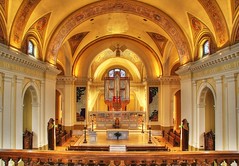This photo below is a fantastic example of the results of HDR or High Dynamic Range imaging.

A Golden Moment
Originally uploaded by !!WaynePhotoGuy.
This is a glowing golden image of the University of St Thomas chapel in St. Paul Mn. Notice the incredible detail and it appears that the entire area is bathed in light. While in reality it was quite dark in this church when this image was taken. How can you get this kind of detail and light and color?
For this particular image I used a relatively new technique called HDR or High Dynamic Range.
HDR, or HDRI stands for High Dynamic Range Imaging. It consists of taking several pictures of the exact same frame, each frame moving from a dark exposure to a light exposure, then combining the pictures. This allows for a photo in which the darkest and lightest parts of the picture have detail , where a single photo of normal exposure won't have detail in these areas.
The specifics of the technique are…
- Just like for all photography you must find a wonderful subject. It is key to train your eye, meaning take the time to do the work to discover what makes an image interesting. You know use the standard rules of art. The rule of thirds, simplify, get closer.. etc. Also remember the magic of light. Good photographers are considered to be painters of light.
- Get a tripod to stabilize you camera. You are going to be taking multiple images of the same scene so you need your camera to be perfectly stabilized.
- Figure out how to make your camera do bracketing. This means figure out how to make your camera take the same image at different exposure settings so that with on push of the button you can take an image that is normal or middle exposure, images that are darker and images that are lighter. Most modern DSLRs can do this automatically. Some of the really cool cameras (like the Nikon D300) can take up to 9 images of differing exposure setting with one push of the button.
- Either manually or with awesome software like photomatix merge your multiple images together into one fantastic image.
- Do some final editing in photoshop or other photo editing tool.
You can see more examples of my HDR work here WaynePhotoGuy's HDR Collection.
Not everyone like this technique. Some people think it is not real or it makes a shot look too fake. Well, for my two cents, I love this technique. It makes many pictures look fantastic and magical.
The software I use is Photomatix from HDRSOFT. You can find more information here.
I am able to offer this software at a significant 15% discount.
To BUY Photomatix at a discount click here And when you purchase any product enter the coupon code WaynePhotoGuy.
Again goto http://www.hdrsoft.com/order.php and when you purchase any product enter the coupon code WaynePhotoGuy.
If you are looking for a great book on the subject this one is the best.



I find HDR photos fascinating with one exception… photos with clouds in the sky. The underside invariably looks sooty, as if the clouds had passed over a field of England’s coal fired chimneys. I’m sure there is a way to avoid this, perhaps using a mask and blending the original clouds in from a layer below. But the clouds in HDR photos often look unnatural and ominous.
I am still learning more about this process and I am doing more and more types of images in this process.
Thank you for your introduction to Photomatix. They are indeed the premiere vendor for HDR software. Thank you also for that recommendation for the book… I bought it and now I can produce HDR almost as good as yours. Thanks a ton!!!
You’re absolutely right about Ferrell’s book. I’ve learned a lot of “little” things that I hope will add up to a lot. He really covers it all.
Your HDRs are great, Wayne!
Thanks Timothy…
Good to hear from you.
I was introduced to HDR recently at a Gerlach photo seminar. Mr. Gerlach is a proponent of HDR and says that although some people think it results in a too-perfect look, HDR actually does a wonderful job of showing what the human eye really takes in and adjusts to when looking at a scene with varied lighting.
Great work!
Temperance and labor are the two best physicians of man; labor sharpens the appetite, and temperance prevents from indulging to excess.